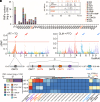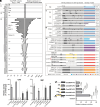Neofunctionalization of an OMT cluster dominates polymethoxyflavone biosynthesis associated with the domestication of citrus
- PMID: 38530892
- PMCID: PMC10998556
- DOI: 10.1073/pnas.2321615121
Neofunctionalization of an OMT cluster dominates polymethoxyflavone biosynthesis associated with the domestication of citrus
Abstract
Polymethoxyflavones (PMFs) are a class of abundant specialized metabolites with remarkable anticancer properties in citrus. Multiple methoxy groups in PMFs are derived from methylation modification catalyzed by a series of hydroxylases and O-methyltransferases (OMTs). However, the specific OMTs that catalyze the systematic O-methylation of hydroxyflavones remain largely unknown. Here, we report that PMFs are highly accumulated in wild mandarins and mandarin-derived accessions, while undetectable in early-diverging citrus species and related species. Our results demonstrated that three homologous genes, CreOMT3, CreOMT4, and CreOMT5, are crucial for PMF biosynthesis in citrus, and their encoded methyltransferases exhibit multisite O-methylation activities for hydroxyflavones, producing seven PMFs in vitro and in vivo. Comparative genomic and syntenic analyses indicated that the tandem CreOMT3, CreOMT4, and CreOMT5 may be duplicated from CreOMT6 and contributes to the genetic basis of PMF biosynthesis in the mandarin group through neofunctionalization. We also demonstrated that N17 in CreOMT4 is an essential amino acid residue for C3-, C5-, C6-, and C3'-O-methylation activity and provided a rationale for the functional deficiency of OMT6 to produce PMFs in early-diverging citrus and some domesticated citrus species. A 1,041-bp deletion in the CreOMT4 promoter, which is found in most modern cultivated mandarins, has reduced the PMF content relative to that in wild and early-admixture mandarins. This study provides a framework for reconstructing PMF biosynthetic pathways, which may facilitate the breeding of citrus fruits with enhanced health benefits.
Keywords: O-methyltransferase; citrus; neofunctionalization; polymethoxyflavone; tandemly duplicated gene cluster.
Conflict of interest statement
Competing interests statement:The authors declare no competing interest.
Figures






Similar articles
-
Two Caffeoyl-CoA O-methyltransferase-like enzyme are involved in the biosynthesis of polymethoxyflavones in Citrus reticulata 'Chachiensis'.Int J Biol Macromol. 2025 May;310(Pt 4):143277. doi: 10.1016/j.ijbiomac.2025.143277. Epub 2025 Apr 25. Int J Biol Macromol. 2025. PMID: 40288725
-
Comparative profiling and natural variation of polymethoxylated flavones in various citrus germplasms.Food Chem. 2021 Aug 30;354:129499. doi: 10.1016/j.foodchem.2021.129499. Epub 2021 Mar 8. Food Chem. 2021. PMID: 33752115
-
A multifunctional true caffeoyl coenzyme A O-methyltransferase enzyme participates in the biosynthesis of polymethoxylated flavones in citrus.Plant Physiol. 2023 Jul 3;192(3):2049-2066. doi: 10.1093/plphys/kiad249. Plant Physiol. 2023. PMID: 37086474 Free PMC article.
-
Polymethoxyflavones from citrus peel: advances in extraction methods, biological properties, and potential applications.Crit Rev Food Sci Nutr. 2024;64(16):5618-5630. doi: 10.1080/10408398.2022.2156476. Epub 2022 Dec 18. Crit Rev Food Sci Nutr. 2024. PMID: 36530054 Review.
-
Genomic insights into citrus domestication and its important agronomic traits.Plant Commun. 2020 Dec 30;2(1):100138. doi: 10.1016/j.xplc.2020.100138. eCollection 2021 Jan 11. Plant Commun. 2020. PMID: 33511347 Free PMC article. Review.
Cited by
-
Microplastics as Emerging Contaminants and Human Health: Exploring Functional Nutrition in Gastric-Colon-Brain Axis Cancer.Toxics. 2025 May 26;13(6):438. doi: 10.3390/toxics13060438. Toxics. 2025. PMID: 40559911 Free PMC article. Review.
-
A long road ahead to reliable and complete medicinal plant genomes.Nat Commun. 2025 Mar 4;16(1):2150. doi: 10.1038/s41467-025-57448-8. Nat Commun. 2025. PMID: 40032878 Free PMC article. Review.
-
Morphological and metabolic changes in Changshan Huyou (Citrus changshan-huyou) following natural tetraploidization.BMC Plant Biol. 2025 Mar 8;25(1):301. doi: 10.1186/s12870-025-06293-4. BMC Plant Biol. 2025. PMID: 40055582 Free PMC article.
-
Transcriptomic and metabolomic analyses reveal the mechanism of color difference between two kinds of Cistanche deserticola before and after drying.Front Plant Sci. 2025 Jan 23;15:1506523. doi: 10.3389/fpls.2024.1506523. eCollection 2024. Front Plant Sci. 2025. PMID: 39917604 Free PMC article.
-
Citrus genomes: past, present and future.Hortic Res. 2025 Feb 4;12(5):uhaf033. doi: 10.1093/hr/uhaf033. eCollection 2025 May. Hortic Res. 2025. PMID: 40224327 Free PMC article.
References
-
- Wang Y., et al. , Polymethoxyflavones from citrus inhibited gastric cancer cell proliferation through inducing apoptosis by upregulating RARβ, both in vitro and in vivo. Food Chem. Toxicol. 146, 111811 (2020). - PubMed
-
- Murakami A., et al. , Inhibitory effect of citrus nobiletin on phorbol ester-induced skin inflammation, oxidative stress, and tumor promotion in mice. Cancer Res. 60, 5059–5066 (2000). - PubMed
-
- Wang H., et al. , Natural Citrus flavanone 5-demethylnobiletin stimulates melanogenesis through the activation of cAMP/CREB pathway in B16F10 cells. Phytomedicine 98, 153941 (2022). - PubMed
-
- Sun Y., et al. , Inhibitory effects of nobiletin and its major metabolites on lung tumorigenesis. Food Funct. 10, 7444–7452 (2019). - PubMed
MeSH terms
Substances
Grants and funding
- 2023YFD2300600/National Key Research and Development Program of China
- 2021hszd016/Hubei Hongshan Laboratory
- 2023YFD2300600/National Key Research and Development Program of China
- 32272685/National Natural Science Foundation of China
- 2021CFA017/Key project of Hubei Provincial Natural Science Foundation
LinkOut - more resources
Full Text Sources
Miscellaneous

